Pilot
-
- Improved Safety and Training, Part II Maritime Reporter, Jul 2017 #14
Step-by-Step Improved Safety & Training - Step #2: Launching a Blended Learning Pilot
Everyone responsible for safety or training in their organization is very aware that everything is changing in the maritime world. The worker demographic has shifted. Regulatory demand is rising and compliance is more complex. Fortunately, it is also the case that maritime safety and training has entered a renaissance period. New tools are available that improve training outcomes and allow organizations to assess the state of training and compliance with a level of insight not previously possible. At the heart of these tools is the practice of blended learning supported by a Learning Management System (LMS) - software to deliver training, assessments, tracking and insights.This is the second is a series of short articles that provides step-by-step instructions on addressing modern safety, training and compliance challenges with the new and highly effective practice of blended learning. The first article, which appeared in last month’s edition of Maritime Reporter, focused on the creation of a minimum viable plan (MVP) for the pilot. This is a two or three page living document which acts as a roadmap for the management of blended learning. With that in place, we now turn to the next step, that of preparing and running a small pilot. The goal of the pilot is to produce a very small blended learning implementation that addresses a small number of trainees and a small number of courses / competencies. This will require minimal time and resources, but produce useful initial results. Let’s get started.Let’s Define SuccessThe overall outcomes we are looking to achieve are improved training results, improved compliance tracking, and the ability to continuously measure the success of our training to inform a process of continuous improvement. The goal of this particular stage, the pilot, is primarily to gain experience. Although there is now a rapidly growing body of experience with blended learning in the maritime industry, each organization and thus each implementation is slightly different. As such, each implementation is a learning experience. Because of this, by far the best approach is to start small, and then grow in incremental stages. The first stage is the pilot.Best Advice: Keep the Pilot Implementation SmallBy definition, the pilot implementation is small. It addresses a limited number of trainees and a limited number of courses or competencies. By keeping the pilot small, we avoid any significant outlay of resources. This allows us to get started without delay. A small pilot also allows us to learn what works (and what does not) very quickly. The effect of any misstep is kept to a minimum and we can quickly apply what we have learned to subsequent stages. This is often referred to as the “fail fast” approach which, despite how it sounds, can be an excellent project management principle. In addition, the successes we achieve in the pilot provide the incentive and resources to deploy the next, larger stage. So there is real benefit in keeping the pilot small.Implementing and Running the PilotThere are many valid approaches to running a successful pilot. Below, we will outline the most important activities to consider and provide some basic suggestions for each.•Engagement and Communication: before anything else, it is important to consider how the pilot program will be communicated to the organization and how stakeholders will be engaged in the creation and running of the pilot. As a first principle, it is imperative that stakeholders at all levels of the organization are involved in the planning of the pilot. This will not only ensure that the pilot is based on complete information, but it also will create buy-in. Training, and especially training transformation, is something that everyone should contribute to – not something imposed on the many by the few. Good practice here is to set up a working group with representation from new and experienced employees covering the various departments within the organization. Be sure to include the operational departments, as well as safety, HR, crewing and so on.Second, communication is critical. It should come from the top, be regular, and be transparent. All members of the organization should understand that the pilot is being undertaken as a product of the organization’s commitment to training and safety, that employees from all levels of the organization are participating in the definition of the pilot, and that the results and next steps will be communicated. Be transparent that this is new territory and that everyone will learn as a result; that is the only path to improvement. Remember that any change requires some organizational culture shift and that transparent communication is a necessary component of success.•Choosing the Training and the Audience: We see many different approaches to choosing the pilot training and audience, but arguably the most common is to address new-hire training. Addressing new hires has the advantage that training materials are often readily available and can easily be converted into an on-line format. Additionally, using blended learning to train new hires helps establish the safety and training culture immediately upon induction – a very positive side effect.•Structure of the Blended Learning Program: There are many ways to blend learning, and thus many options. However, arguably the most direct, most effective and most popular is the one deployed by BC Ferries in 2007. Their blended learning approach to familiarization training was part of a safety culture transformation that reduced accidents by two-thirds and reduced annual insurance costs by three-quarters (millions of dollars per year).
Here, we divide the training into three parts: self-study, in-person training, and assessment. The self-study component is fully on-line. Trainees use this resource to learn, at their own pace, the foundational knowledge of the topic at hand. For example, if new-hire training is the subject of the pilot, the on-line resource will teach company organization, company culture, basic safety information, the regulatory framework, and any other topic that all new hires must be aware of. An on-line exam should follow the self-study to ensure that each trainee has absorbed and understood the information.Next, in-person training, conducted by an expert, is used to train skills, relate personal experience, work through group or individual exercises, and further consolidate knowledge. This stage is made very efficient and effective by the fact that all trainees come to it with a uniform and reliable level of knowledge from the self-study.And finally, an assessment is conducted to ensure that trainees are fit for duty. Depending on what is being tested, a combination of on-line assessments (to test knowledge), demonstrative exams (to test skills) and oral assessments (to test reasoning ability) can be employed.•Implementing the Learning: The primary effort here is to prepare the on-line materials necessary to support the self-study and deploy those, along with any assessments, on your chosen learning management system (LMS). A good marine-focused LMS vendor can assist with this and advise on best practice. Additionally, the in-class portion of the training should be planned along with final assessments.•Running the Pilot: Once the pilot is set up, it is time to put your first trainees through it. The pilot group should include a number of new trainees alongside some more experienced employees who have been through more traditional training. These experienced employees can provide a comparative perspective.What’s Next?Once the pilot is complete, we move on to what it arguably the most important phase. This is where we analyze and collect the results of the pilot, and then use those to inform the next and subsequent phases of rollout. It is important enough that we will devote the entire third and final installment of this series to it. So, please check this space next month in Maritime Reporter & Engineering News.The AuthorMurray Goldberg is CEO of Marine Learning Systems, maker of MarineLMS. A researcher and developer of learning management systems, his software has been used by millions of people and companies worldwide.(As published in the July 2017 edition of Maritime Reporter & Engineering News) -
- Precision Ship-Handling Writ Large Maritime Reporter, Sep 2002 #34
it sent highly trained young people to sea. Some of those, after gaining years of deep sea experience, returned to Hamburg to become river and docking pilots. The Port has two pilot stations and two pilotage authorities. The Harbor Pilots (Hafenlotsenbriiiiderschaft), of which there are about 45, work
-
- Bridge Heights Are Not Guesswork: Accuracy Is Imperative Marine News, Oct 2020 #20
“Your true pilot cares nothing about anything on earth but the river, and the pride in his occupation surpasses the pride of kings.” -Mark Twain, Life on the Mississippi (1883).That statement made by the great chronicler and river pilot over 137 years ago is arguably as true today as it was then.
-
- There’s No Such Thing as a Routine Grounding Marine News, May 2014 #22
involved master requiring a vigorous license defense. What made this case different than most was the fact that because the charged master was serving as a pilot (independent contractor) at the time of the incident, he also had a significant professional liability exposure as a consequence of the grounding’s
-
- New Transas Pilot PRO Maritime Reporter, Jul 2015 #41
Transas released a new version of Transas Pilot PRO, iPad-based chart plotter for professional pilots and mariners. It is designed to make the job easier for pilots and other marine professionals in their daily routine. Version 2.0.5 includes Vessel Parking System (VPS), which ensures high precision
-
- Delaware Marine Launches Pilot Boat For Port Of Monrovia Maritime Reporter, Jun 1977 #51
The pilot boat Ducor was recently launched at Delaware Marine & Manufacturing Company shipyard at Milford, Del. Those on hand at the launching included Delaware State Senator Thurman Adams, Milford Mayor Herman S. McNatt, Kurt Schneider, who represented the National Port Authority, and State Representa
-
- Hawaii, Lockheed, Dillingham Announce They Will Build, Operate Ocean-Fueled Energy Pilot Plant Maritime Reporter, Nov 1978 #60
An e l e c t r i c - p o w e r generator floating on the Pacific Ocean and using warm surface water heated by solar radiation for fuel will begin test operations next spring. It will be the first at-sea closedcycle Ocean Thermal Energy Conversion (OTEC) plant that will generate usable amounts of
-
- Halter Delivers New York Pilot Boat Maritime Reporter, Feb 1974 #29
Services, Inc., New Orleans, La., the world's largest builder of offshore support vessels for the oil and gas industry, has delivered a new 65-foot pilot vessel to the New York Pilots Association. The new boat, named Chapel Hill, will accommodate 19 pilots and has been placed into operation by its
-
- Demand for ROV Pilot Technicians Grows Marine Technology, Jul 2013 #72
which this has been particularly noticeable is in remotely operated vehicles (ROVs). As the demand for ROVs increases, so does the need for qualified ROV Pilot technicians. Fueled by the search for oil in ever deeper waters and utilizing numerous strands of technology, the world of ROVs is breaking new ground
-
- U.S. Army Corps Selects 10 Beneficial Use Pilot Projects Marine News, Feb 2019 #26
At the end of December, the U.S. Army Corps of Engineers (ACE) announced its selection of ten dredging projects that will form the core of a pilot program to advance the beneficial use of dredged material.The recent U.S. Army Corps of Engineers’ announcement culminated a program required by Congress
-
- Marco Shipyard Concludes Pilot Station Vessel Contract Maritime Reporter, Jul 2001 #20
Marco Shipyard has concluded its contract for two new pilot station vessels for the San Francisco Bar Pilots with the delivery of the 104-ft. (31.7-m) California — sistership to San Francisco. Outfitted with the latest navaids and communications technology, the new Marco-designed boats transfer
-
- Derecktor Shipyard Wins Contract For Two Pilot Boats Maritime Reporter, Feb 2000 #66
Derecktor Shipyards signed a contract with the New York/New Jersey Sandy Hook Pilots Association for the construction of two all aluminum fast pilot boats. The two vessels will be built according to plans by Camarc Small Craft Designs of Worthing, U.K. in Derecktor's Mamaroneck, N.Y. facility. Delivery
-
 )
March 2024 - Marine Technology Reporter page: 33
)
March 2024 - Marine Technology Reporter page: 33pumps to Oil States’ Merlin riser systems were lift nodules into a collection drum. successfully deployed on both the TMC / Allseas and JAMSTEC 2022 pilot projects. They also hold a world record water depth for a producing riser sys- tem of 14,764 feet. Impossible Metals is developing a nod- ule collector
-
 )
March 2024 - Marine Technology Reporter page: 32
)
March 2024 - Marine Technology Reporter page: 32FEATURE SEABED MINING by a sea? oor plume from its pilot collection system test. pact, nodule collection system that utilizes mechanical and The Metals Company recently signed a binding MoU with hydraulic technology. Paci? c Metals Corporation of Japan for a feasibility study on The company’s SMD
-
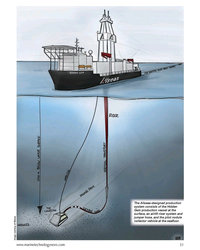 )
March 2024 - Marine Technology Reporter page: 31
)
March 2024 - Marine Technology Reporter page: 31The Allseas-designed production system consists of the Hidden Gem production vessel at the surface, an airlift riser system and jumper hose, and the pilot nodule collector vehicle at the sea? oor. Image courtesy of Allseas www.marinetechnologynews.com 31 MTR #3 (18-33).indd 31 4/4/2024 2:12:41 P
-
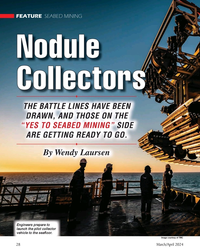 )
March 2024 - Marine Technology Reporter page: 28
)
March 2024 - Marine Technology Reporter page: 28BATTLE LINES HAVE BEEN DRAWN, AND THOSE ON THE “YES TO SEABED MINING” SIDE ARE GETTING READY TO GO. By Wendy Laursen Engineers prepare to launch the pilot collector vehicle to the sea? oor. Image courtesy of TMC 28 March/April 2024 MTR #3 (18-33).indd 28 4/4/2024 2:10:10 P
-
 )
March 2024 - Marine Technology Reporter page: 14
)
March 2024 - Marine Technology Reporter page: 14or hardware integrations. tions,” said Quinn. “The size of the Sentinel gives it the energy capacity to in- The Slocum Sentinel Glider uses the established piloting, crease mission length to over 2 years; or users can ? t more ? ight control, and communications architecture of the Slocum high-energy sensors
-
 )
April 2024 - Maritime Reporter and Engineering News page: 39
)
April 2024 - Maritime Reporter and Engineering News page: 39Tech Files Latest Products, Systems and Ship Designs “Wall Climbing Robot” Danish Pilot calls gets ClassNK Nod LEGO Model "A tribute build to a work life at sea" Image courtesy MOL, Sumitomo Heavy Industries lassNK granted its Innovation Endorse- Image courtesy Espen Andersen/DanPilot ment for
-
 )
April 2024 - Maritime Reporter and Engineering News page: 35
)
April 2024 - Maritime Reporter and Engineering News page: 35will offer unprecedented model accuracy in a 2022 King’s College London study said that they feel like as well as enhanced line forces calculations for pilot training their attention span is shorter than it used to be. They are wrong, undertaken at Smartship Australia. though, if they think that the average
-
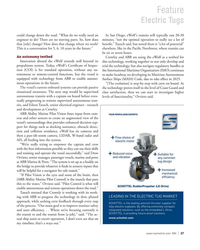 )
April 2024 - Marine News page: 37
)
April 2024 - Marine News page: 37to remote supervised autonomous tran- sits, said Eileen Tausch, senior electrical engineer - research and development at Crowley. ABB Ability Marine Pilot Vision fuses input from cam- eras and other sensors to create an augmented view of the vessel’s surroundings that provides enhanced decision sup- port
-
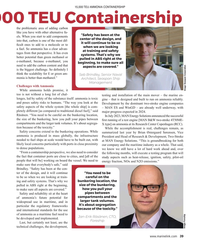 )
February 2024 - Maritime Reporter and Engineering News page: 39
)
February 2024 - Maritime Reporter and Engineering News page: 39a testing program that will the fact that container ports are close to cities, and [all of the study aspects such as heat-release, ignition, safety, pilot-oil people that will be] working on board the vessel. We need to energy fraction, NOx and N2O emissions.” make sure that everybody's safe,” said
-
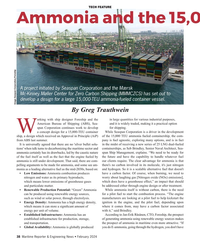 )
February 2024 - Maritime Reporter and Engineering News page: 38
)
February 2024 - Maritime Reporter and Engineering News page: 38Production Potential: “Green” Ammonia While ammonia itself is without carbon, there is the need can be produced using renewable energy sources, for a pilot fuel to start the combustion process. “The engine such as wind or solar power, through electrolysis. manufacturers are looking at a pilot fuel to
-
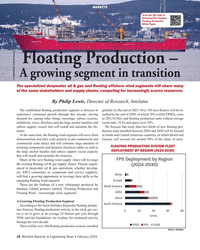 )
February 2024 - Maritime Reporter and Engineering News page: 18
)
February 2024 - Maritime Reporter and Engineering News page: 18be located At the same time, the ? oating wind segment will move from in South and Central American countries, of which Brazil and demonstration and pilot scale projects to pre-commercial and Guyana will account for around 90% of the share of units. commercial scale arrays and will consume large amounts
-
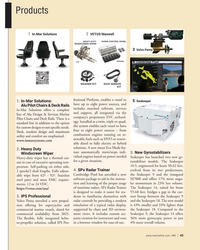 )
February 2024 - Marine News page: 43
)
February 2024 - Marine News page: 43Penta 4 Cambridge Pixel fessional Platform, enables a vessel to Seakeeper 1. In-Mar Solutions: 5 have up to eight power sources, and Alu Pilot Chairs & Deck Rails In-Mar Solutions offers a complete includes matched software, services line of Alu Design & Services Marine and support, all
-
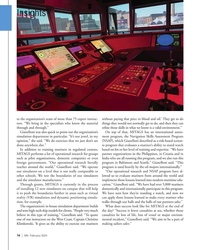 )
February 2024 - Marine News page: 14
)
February 2024 - Marine News page: 14and expertise. “We have MITAGS performs a lot of operational research for groups partner organizations in the Philippines, in Croatia and in such as pilot organizations, domestic companies or even India who are all running this program, and we also run this foreign governments. “Our operational research
-
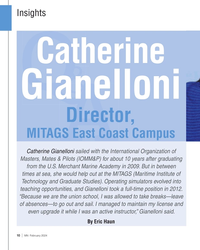 )
February 2024 - Marine News page: 10
)
February 2024 - Marine News page: 10QQQQQQQQQAAA & Gianelloni Director, MITAGS East Coast Campus Catherine Gianelloni sailed with the International Organization of Masters, Mates & Pilots (IOMM&P) for about 10 years after graduating from the U.S. Merchant Marine Academy in 2009. But in between times at sea, she would help out at the
-
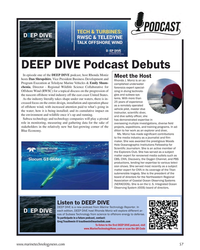 )
January 2024 - Marine Technology Reporter page: 57
)
January 2024 - Marine Technology Reporter page: 57on the entire design, installation and operation phase as a remotely operated of offshore wind, with increased attention paid to what’s going in vehicle pilot, master dive the water; how it is being installed; and its cumulative impact on instructor, scienti? c diver, the environment and wildlife once
-
 )
January 2024 - Marine Technology Reporter page: 56
)
January 2024 - Marine Technology Reporter page: 56one of the providers for the offshore wind platform. So, is to prove the concept,” said Ortega. Apart from the technical, we’re not only talking about a pilot; we’re also talking about Gazelle is actively seeking partnerships – from developers to some speci? c projects that we’re planning to use our offshore
-
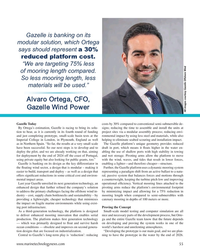 )
January 2024 - Marine Technology Reporter page: 55
)
January 2024 - Marine Technology Reporter page: 55provides reduced have been successful. So our next steps is to develop and to draft in port, which means it ? oats higher in the water en- deploy the pilot, and we are already working on that, aiming abling the use of shallow ports with high stability in towing for deployment by the end of 2024 off the
-
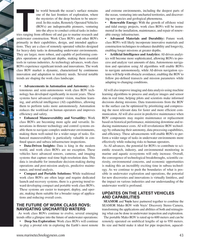 )
January 2024 - Marine Technology Reporter page: 43
)
January 2024 - Marine Technology Reporter page: 43. These learning algorithms to process and analyze images and sensor systems have advanced computer vision, machine learn- data in real time, helping pilots and scientists make informed ing, and arti? cial intelligence (AI) capabilities, allowing decisions during missions. Data transmissions from the
-
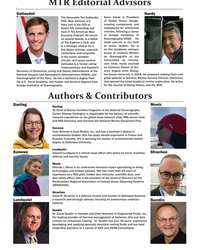 )
January 2024 - Marine Technology Reporter page: 6
)
January 2024 - Marine Technology Reporter page: 6J. Moniz is an underwater forensics expert specializing in diving technologies and subsea systems. She has more than 25 years of experience as a ROV pilot, master dive instructor, scienti? c diver, and dive safety of? cer. She is the president of the board of directors for the Northeastern Regional
-
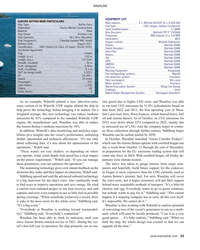 )
January 2024 - Maritime Reporter and Engineering News page: 33
)
January 2024 - Maritime Reporter and Engineering News page: 332021 Radars: Wärtsilä (SAM) Classi? cation: DNV, Finnish Ice Class 1A Super; SOLAS 2020; Depth Sounders: Wärtsilä (SAM) Stockholm Agreement Auto Pilot: Wärtsilä (SAM) Flag: Finland Radios: Wärtsilä (SAM) Length, (o.a.): 150 m AIS: Wärtsilä (SAM) Length, (b.p.): 137.02m GPS: Wärtsilä
-
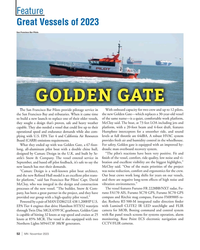 )
November 2023 - Marine News page: 52
)
November 2023 - Marine News page: 52Feature Great Vessels of 2023 San Francisco Bar Pilots GOLDEN GATE The San Francisco Bar Pilots provide pilotage service in With onboard capacity for two crew and up to 12 pilots, the San Francisco Bay and tributaries. When it came time the new Golden Gate—which replaces a 30-year-old vessel to build a
-
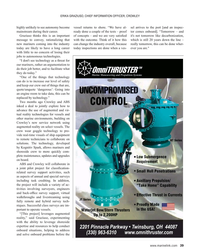 )
November 2023 - Maritime Reporter and Engineering News page: 39
)
November 2023 - Maritime Reporter and Engineering News page: 39, allows mariners and shoreside crew to more quickly com- plete maintenance, updates and upgrades on board. ABS and Crowley will collaborate in a joint pilot project for classi? cation- related survey support activities, such as aspects of annual and special surveys including task crediting. In addition
-
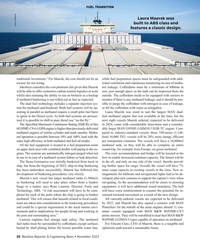 )
November 2023 - Maritime Reporter and Engineering News page: 28
)
November 2023 - Maritime Reporter and Engineering News page: 28for methanol and biodiesel. Both fuel systems will be op- or ? ll the cofferdam with water as mitigation. erating in parallel as methanol require a small pilot fuel burst Laura Maersk was sized to suit the largest MAN dual- to ignite in the Diesel cycle. As both fuel systems are pressur- fuel methanol engine
-
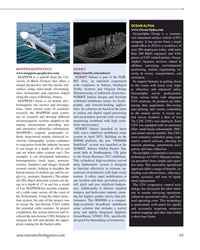 )
September 2023 - Marine Technology Reporter page: 69
)
September 2023 - Marine Technology Reporter page: 69forward-looking applica- encing data acquisition, life-saving, tions. After several years of academic tions. Its solutions are based on the latest auto-piloting and swarm controlling research, the MAPPEM team contin- in analog and digital signal processing in the marine sector. A recent sea- ues to research
